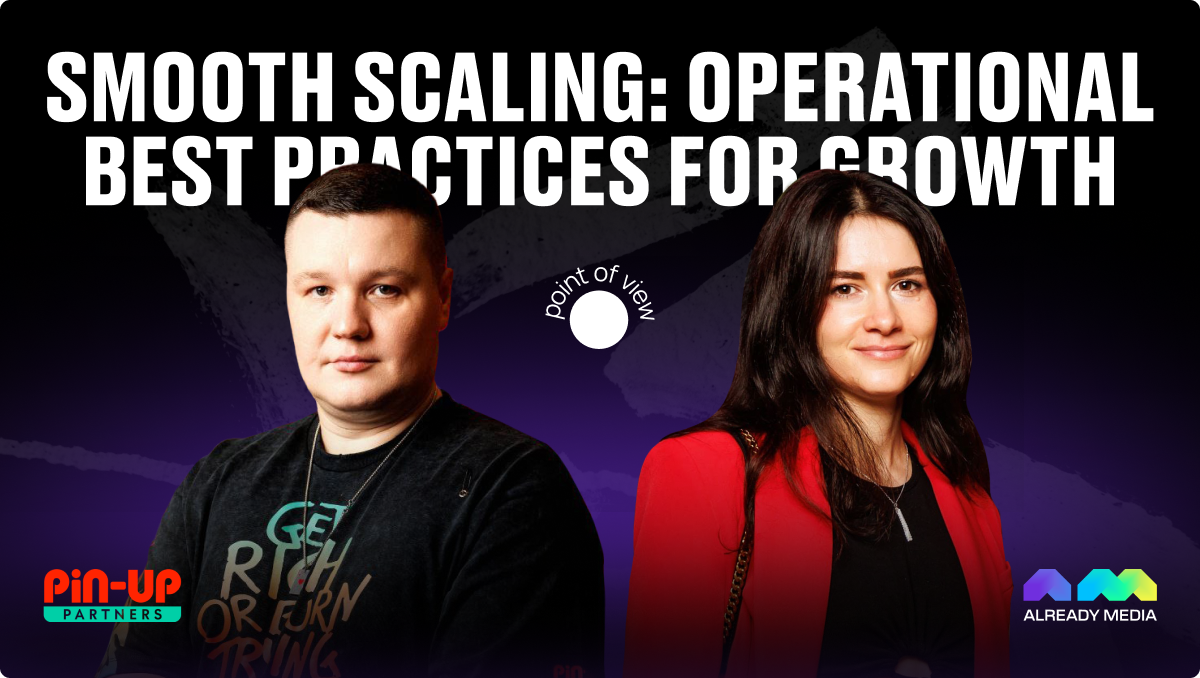
Introduction
How do companies build efficient operational processes to keep up with global growth and scaling? In the third issue of “Point of View,” we’ve gathered insights from top industry experts: Vitalii Fihel, Head of PIN-UP Partners, and Natalia Shchedrina, COO of Already Media. They shared their approaches to process optimization, balancing flexibility with standardization, and leveraging data for decision-making.
Automation and Data-Driven Optimization
What approaches do you use to optimize operational processes amidst global growth?
“Firstly, a large holding like ours always focuses on automation. It helps us accelerate processes, reduce errors, and concentrate on partner interactions. Secondly, PIN-UP Partners is actively developing local teams. Considering regional specifics is crucial for maintaining high efficiency in certain GEOs. Another key point is analytics. We invest significant resources to identify bottlenecks and address inefficiencies promptly. This applies to both systematic data and valuable feedback from our partners. Their insights help us make important decisions. Lastly, continuous team training is vital for forward momentum.” – Vitalii Fihel
How do you use data to forecast operational needs? What role do analytical tools play in resource planning and identifying potential problem areas?
“At Already Media, analytical data forms the foundation for both managing current tasks and strategic planning. We track key metrics at the department, team, and company levels. This helps us identify bottlenecks, reallocate resources, and adjust timelines and budgets. Our in-house analytical tools, built using cutting-edge technology, provide a competitive advantage by being tailored to our processes and teams.” – Natalia Shchedrina
Creating Structure Without Stifling Innovation
How can a company formalize its workflow? What framework or documentation format should be used to transition from informal actions to a structured, transparent system?
“For us, workflow formalization is about building a transparent and manageable system, not creating unnecessary bureaucracy. We transition tasks from intuitive execution to a structured approach where everyone understands their role and responsibilities. The key idea is to create simple, clear rules applicable at all levels. We avoid overloading processes with details, focusing on making them flexible yet reliable.” – Vitalii Fihel
How do you balance automation with human capital? In which processes is full reliance on technology necessary, and where is the human factor indispensable?
“We use automation for routine tasks requiring accuracy and defined algorithms, such as reporting and analytics. This optimizes employees’ time, allowing them to focus on more strategic priorities. The human factor is crucial in areas requiring flexible thinking, creativity, and adaptability—especially when solving unique problems or generating new ideas.” – Natalia Shchedrina.
Balancing Flexibility and Standardization for Growth
How do you effectively balance flexibility and standardization, especially during rapid growth and expansion?
“There’s no universal solution here; an adaptive approach is essential. Without clearly defined processes and rules, scaling efforts can descend into chaos. However, over-regulation isn’t a cure-all either. Our goal is to ensure that standards support, rather than stifle, team initiatives. Flexibility allows us to adapt quickly to new conditions and challenges. Regular feedback from our team and partners helps us fine-tune our standards where needed. In short, PIN-UP Partners automates wherever possible but leaves room for flexibility where creativity and unique approaches matter.” – Vitalii Fihel
How do you develop a competency assessment system during rapid growth? What tools or methodologies do you use to identify skill gaps and ensure appropriate training?
“We develop competency systems and grading scales for each role. Our performance reviews assess not only current skill levels but also developmental progress. We consider key metrics and gather feedback from colleagues, managers, and the employees themselves to identify areas for improvement and adjust training accordingly.” – Natalia Shchedrina:
Conclusion and Key Takeaways
Operational processes in a growing and scaling environment require a comprehensive approach that combines automation, standardization, and flexibility. Natalia Shchedrina and Vitalii Fihel shared key strategies that help their companies remain efficient and resilient in dynamic markets.
Key Takeaways:
- Automation Drives Efficiency: Both companies leverage automation to optimize routine tasks, freeing teams to focus on strategic and creative initiatives.
- Flexibility and Standards Must Coexist: Successful companies avoid excessive bureaucracy and create adaptable processes that empower teams. Standards should support, not restrict, innovation.
- Data is Central to Decision-Making: Accurate analytics and robust tools help predict bottlenecks, allocate resources, and adjust strategies in real-time. Both quantitative data and qualitative feedback are crucial.
- Investing in Team Development is Essential: Continuous training, competency assessment, and feedback loops are key to sustainable growth. Companies that invest in their people gain a competitive edge.
- Transparent Communication is Critical: Formalized processes create a transparent system where every team member understands their role and responsibilities, essential for managing rapid growth.
Operational processes are not static structures but dynamic systems that require constant analysis and adaptation. The experiences of Already Media and PIN-UP Partners demonstrate that successful scaling relies on balancing technology, human capital, and transparent analytics. The key is to create standards that support initiative and use data as the foundation for strategic decisions.
Stay tuned for the next “Point of View” issue for more industry insights from leading experts!

